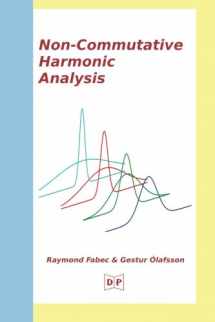
Non-Commutative Harmonic Analysis
Book details
Summary
Description
The text covers basic material in harmonic analysis. It assumes a background in measure theory and integration, some operator theory, and basic topology. Some early material can be covered by undergraduates willing to overlook some technical details. Beginning topics include periodic functions, Fourier series and their convergence, and a fairly broad introduction to topological vector spaces and integral operators. Next comes a standard presentation of the Fourier integral. Inversion formulas are given for integrable, square integrable, and Schwartz functions. The book continues by covering special topics. These include the Paley-Wiener Theorem, the wave equation, the Sobolev Lemma, the Heisenberg uncertainty principle, windowed Fourier transforms, and wavelet transforms and inversion formulas. The latter part of the book covers non-commutative harmonic analysis. It is within this framework that the topics appearing earlier in the text can be further illuminated and developed. Some of this material is abstract and general. It starts with topological groups, their homogeneous spaces, and classical examples. This is followed by a chapter on representation theory. There the Haar integral, invariant measures, representations of algebras and groups, abstract sums and decompositions, Schur's Lemma, tensor products, regular representations, induced and square integrable representations, and many other topics are discussed. Of particular note is the close connection between square integrable representations and transforms and inversion formulas. Instances of these are the windowed Fourier transform and wavelet transforms given earlier. This material is also central to the last two chapters of the text. The first of these is a chapter on the Heisenberg group. From the momentum and position operators of quantum mechanics, a formal construction of the irreducible unitary representations is given and one is led into the realm of infinite dimensional non-commutative harmonic analysis. Topics covered in this chapter include the orthogonality of matrix coefficients, the Wigner and Weyl transforms, twisted convolution, and an explicit Plancherel formula. This chapter makes extensive use of earlier material on the Fourier integral and integral operators. The last chapter is on compact Hausdorff groups. In these cases, irreducible representations are finite dimensional and all matrix coefficients are square integrable. Moreover, all representations are discretely decomposable and one deals only with discrete sums to decompose functions into their simpler parts. Topics here include induced representations, Frobenius reciprocity, primary projections, and in the case of homogeneous spaces, spherical functions and Gelfand pairs. The chapter concludes by first considering the case of abelian compact groups and then the case of finite groups. In the abelian case, the Pontryagin duality theorem is presented. For finite groups we give the Wedderburn Theorem. This is a complete description of the group algebra. The book is interspersed with several exercise sets. The problems in these sets range from simple to challenging. Some are used as parts of proofs and others to reinforce the topics covered in the central text. The authors hope the text is useful to students aspiring to learn harmonic analysis and to working scientists and mathematicians who want reference material on some topic of interest in their own work.


We would LOVE it if you could help us and other readers by reviewing the book
Book review



